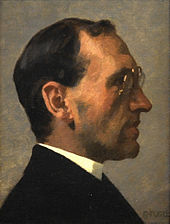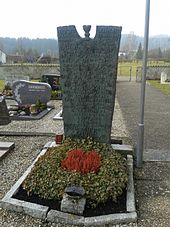Josef Weiger

Josef Weiger (born June 10, 1883 at Zeil Castle near Leutkirch in Allgäu , † August 27, 1966 in Mooshausen near Aitrach ) was a Roman Catholic pastor and theologian.
Life
Weiger was born and raised in Schloss Zeil, a suburb of the municipality of Leutkirch in the Allgäu. On October 31, 1903 he entered the Archabbey of Beuron as Brother Martin . After less than two years, on February 8, 1905, he left the monastery to become a secular priest in the Rottenburg diocese . At this step, he had the full approval of Erzabt Placidius Wolter . In addition, the Allgäu studied in Tübingen , where he first met Romano Guardini . This was followed for many years in the small parish of Mooshausen in Upper Swabia on the edge of the Allgäu in Württemberg . His heart has belonged to the liturgy and questions about the liturgy of the Church since his time in Beuron. Most of his liturgical publications had passed their test in the parish church of Mooshausen before they went to print.
He was given an honorary doctorate in Tübingen and, along with Karl Neundörfer, was Romano Guardini's closest friend. The latter found refuge in the parsonage of Mooshausen in 1943 during the turmoil and persecution in the dictatorship of National Socialism, after he was no longer able to stay in Berlin . Since 1917, Weiger and his rectory were the center of a large circle of friends, especially, but not only, of theologians.
Weiger's few publications were sufficient for Fridolin Stier to describe him as a “religious writer of high theological rank” when he was awarded an honorary doctorate . This includes above all his book The Body of Christ in History and Mystery (Würzburg 1950). The main themes were the liturgy , especially the celebration of the Eucharist and Mariology . Together with Otto Karrer, he was one of the first theologians in Germany to study the works of Cardinal John Henry Newman . A Freundeskreis e. V., who develops the intellectual and spiritual legacy for the present with events and publications.
The tomb in the village cemetery of Mooshausen for Pastor Josef Weiger was created by the artist Maria Elisabeth Stapp .
Works
- Liturgical Book of Mary , Mainz 1924
- Liturgical Book of the Dead , Mainz 1924
- Liturgical weekly book , Mainz 1925
- Mother of the New and Eternal Covenant , Würzburg 1936
- The body of Christ in history and mystery , Würzburg 1950
- Maria von Nazareth , Munich 1954
literature
- Ekkart Sauser : Weiger, Josef. In: Biographisch-Bibliographisches Kirchenlexikon (BBKL). Volume 13, Bautz, Herzberg 1998, ISBN 3-88309-072-7 , Sp. 599-602.
See also
Web links
- Friends of Mooshausen
- Literature by and about Josef Weiger in the catalog of the German National Library
| personal data | |
|---|---|
| SURNAME | Weiger, Josef |
| ALTERNATIVE NAMES | Weiger, Martin (religious name) |
| BRIEF DESCRIPTION | German Roman Catholic pastor and theologian |
| DATE OF BIRTH | June 10, 1883 |
| PLACE OF BIRTH | Zeil Castle near Leutkirch in the Allgäu |
| DATE OF DEATH | August 27, 1966 |
| Place of death | Mooshausen near Memmingen |
